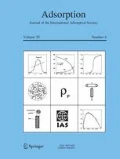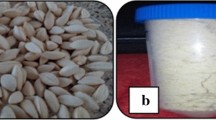Abstract
A novel adsorbent was developed from mature leaves of the Neem tree (Azadirachta Indica) for removing metal ions from water. The adsorbent, in the form of fine powder, was found to be very effective in removing chromium (VI) from aqueous solution. The adsorption was carried out in a batch process taking different concentrations of the metal ion in aqueous solution with variation in adsorbent amount, pH, agitation time and temperature. The suitability of the adsorbent was tested with Langmuir and Freundlich isotherms and with various equilibrium kinetic data. A small amount of the Neem Leaf Powder (NLP) (1.6 g dm−3) could remove as much as 87% of Cr (VI) in 300 min from a solution of concentration 14.1 mg dm−3 at 300 K. The optimum range of pH for the adsorption process was 4.5–7.5 and since the natural pH of the Cr (VI) solution was 5.5, no addition of acid or alkali was necessary for achieving maximum adsorption. The adsorption coefficients indicated a high potentiality for the NLP to be used as an adsorbent for removing Cr (VI) from water.
Similar content being viewed by others
References
Aksu, Z., U. Acikel, E. Kabasakal, and S. Tezer, “Equilibrium modeling of individual and simultaneous biosorption of chromium (VI) and Ni (II) onto dried activated sludge”, Water Res., 36, 3063–3073 (2002).
ATSDR, “Chromium Fact Sheet, Agency for Toxic Substances and Disease Registry (ATSDR)”, USA (http://www.atsdr.cdc.gov), 2001.
Bailey, S.E., T.J. Olin, R.M. Bricka, and D.D. Adrian, “A Review of Potentially Low Cost Sorbents for Heavy Metals”, Walter Res., 33, 2469–2479 (1999).
Bayat, B., “Comparative Study of Adsorption Properties of Turkish Fly Ashes. II. The Case of Chromium (VI) and Cadmium (II)”, J. Hazardous Materials, 95, 275–290 (2002).
Chattopadhyay, R.R., R.N. Chattopadhyay, and S.K. Maitra, “Possible Mechanism of Anti-Inflammatory Activity of Azadirchta Indica Leaf Extract”, Indian J. Pharmacol, 25, 99–100 (1993).
Chopra, R.N., S.L. Nayer, I.C. Chopra, Glossary of Indian Medicinal Plants, p. 31, C.S.I.R., New Delhi, 1956.
Chu, K.H., “Removal of Copper from Aqueous Solution by Chitosan in Prawn Shell: Adsorption Equilibrium and Kinetics”, J. Hazardous Materials, B90, 77–95 (2002).
Cieslak-Golonka, M., “Toxic and Mutagenic Effects of Chromium (VI)”, Polyhedron, 15, 3667–3689 (1995).
Dakiky, M., M. Khamis, A. Manassra, and M. Mereb, “Selective Adsorption of Chromium (VI) in Industrial Wastewater Using Low-Cost Abundantly Available Adsorbents”, Advances in Environmental Research, 6, 533–540 (2002).
Daneshvar, N. D. Salari, and S. Aber, “Chromium Adsorption and Chromium (VI) Reduction to Trivalent Chromium in Aqueous Solutions by Soya Cake”, Journal of Hazardous Materials, B94, 49–61 (2002).
Dantas, T.N. De Castro, A.A. Dantas Neto, and M.C.P. De A. Moura, “Removal of Chromium from Aqueous Solutions by Diatomite Treated with Microemulsion”, Water Res., 35, 2219–2224 (2001).
Dutta, M., “Adsorption of Certain Beta-Lactam Antibiotics on Activated Carbon/Polymeric Resins: Equilibrium and Kinetic Studies”, Ph.D. thesis (unpublished), Gauhati University, India, 1999.
Gupta, V.K., M. Gupta, and S. Sharma, “Process Development for the Removal of Lead and Chromium from Aqueous Solutions Using Red Mud—An Aluminum Industry Waste”, Water Res., 35, 1125–1134 (2001).
Hall, K.R., L.C. Eagleton, A. Acrivos., and T. Vermeulen, “Pore and Solid Diffusion Kinetics in Fixed Bed Adsorption under Constant Pattern Conditions”, Ind. Eng. Chem. Fund., 5, 212–219 (1966).
Ho, Y.S. and G. Mckay, “A comparison of Chemisorption Kinetic Models Applied to Pollutant Removal on Various Sorbents”, Trans. IChemE., 76B, 332–340 (1998).
Ho, Y.S. and G. Mckay, “Comparative Sorption Kinetic Studies of Dyes and Aromatic Compounds onto Fly Ash”, J. Environ. Sci. Health, A34, 1179–1204 (1999).
Khan, S.A., R. Rehman and M.A. Khan, “Adsorption of Cr (III), Cr (VI) and Ag (I) on Bentonite”, Waste Mgmt., 15, 271–282 (1995).
Kraus, W., “Biologically Active Ingredients”, in The Neem Tree, H. Schmutterer (Ed.), pp.35–92, VCH, Weinheim, 1995.
Langmuir, K., J. Chem. Soc., 40, 1361 (1918).
Majumdar, A.M., A.S. Upadhyay, and A.M. Pradhan, “Effect of Azadirachta Indica Leaf Extract on Carbontetrachloride-Induced Hepatic Damage in Albino Rats”, Indian J. Pharm. Sci., 60, 363–367 (1998).
Namasivayam, C. and R.T. Yamuna, “Adsorption of Chromium (VI) by a Low Cost Adsorbent: Biogas Slurry”, Chemosphere, 30, 561–578 (1995).
National Research Council, Neem: A Tree for Solving Global Problems, Report of an adhoc panel of the Board on Science and Technology for International development, National Academy Press, D.C. Washington, 1992.
Neem Foundation, Chemical composition of Neem Tree, from the website http://www.neemfoundation.org, 1997.
Norseth, T., “The Carcinogenicity of Chromium and its Salts”, Br. J. Ind. Med., 43, 649–651 (1986).
Panday, K.K, G. Prasad, and V.N. Singh, “Removal of Cr(VI) from Aqueous Solution by Adsorption on Fly Ash Wollastonites”, J. Chem. Technol. Biotechnol. A-Chemical Technology, 34, 367–374 (1984).
Rawat, N.S., “Neem Plantation for Better Pesticides for Reducing Poverty and for Protecting Environment in India”, Indian J. Environ. Protection, 14, 433–439 (1994).
Sanches-Polo, M. and J. Rivera-Utrilla, “Adsorbent-Adsorbate Interactions in the Adsorption of Cd(II) and Hg(II) on Ozonized Activated Carbons”, Environ. Sci. Technol., 36, 3850–3854 (2002).
Schmutterer, H., “The Tree and its Characteristics”, in The Neem Tree, H. Schmutterer (Ed.), PP.1–34, VCH, Weinheim, 1995.
Sharma, D.C. and C.F. Forster, “Removal of Hexavalent Chromium Using Sphagnum Moss Peat”, Water Res., 27, 1201–1208 (1993).
Sharma, D.C. and C.F. Forster, “The Treatment of Chromium Wastewaters Using the Sorptive Potential of Leaf Mold”, Bioresource Technol., 49, 31–40 (1994).
Sharma, D.C. and C.F. Forster, “Removal of Hexavalent Chromium from Aqueous Solutions by Granular Activated Carbon”, Water SA, 22, 153–160 (1996).
Skellon, J.H., S. Thorburn, J. Spence, S.N. Chatterjee (1962). The Fatty Acids of Neem Oil and their Reduction Products, Journal of Scientific Food Agriculture, 13, 639–643 (1962).
Summers, R.S. and P.V. Roberts, “GAC Adsorption of Humic Substances II. Size Exclusion and Electrostatic Interactions”, J. Colloid. Interface. Sci., 122, 382–397 (1988).
Thomas, W. John, “Crittenden, Barry”, in Adsorption Technology and Design, Butterworth, Heinemann, Oxford, 1998.
US Department of Health and Human Services, Toxicological Profile for Chromium, Public Health Services Agency for Toxic Substances and Disease Registry, DC Washington, 1991.
Venugopal, P.V. and T.V. Venugopal, “Antidermatophytic Activity of Neem (Azadirachta indica) Leaves In Vitro”, Indian J. Pharmacol., 26, 141–143 (1994).
Vogel, A.I., Textbook of Quantitative Inorganic Analysis, p. 791, 3rd edn., ELBS, 1969.
Weber, W.J. and J.C. Morris, “Kinetics of Adsorption on Carbon Solution”, J. San. Eng. Div. ASCE, 89, 31–59 (1963).
WHO, Technical Report Series, No. 546 (Assessment of Carcinogenicity and Mutagenicity of Chemicals—Report of a WHO Scientific Group), World Health Organization, Geneva, 19 p. 1974.
Wu, Feng-Chin, Tseng, Ru-Ling, and Juang, Ruey-Shin. “Comparative Adsorption of Metal and Dye on Flake- and Bead-Types of Chitosans Prepared from Fishery Wastes”, J. Hazard. Materials, B73, 63–75 (2000).
Yabe, Maria Josefa Santos and de Oliveira, Elisabeth. “Heavy Metals Removal in Industrial Effluents by Sequential Adsorbent Treatment”, Advances in Environmental Research, 7, 263–272 (2003).
Author information
Authors and Affiliations
Corresponding author
Rights and permissions
About this article
Cite this article
Sharma, A., Bhattacharyya, K.G. Adsorption of Chromium (VI) on Azadirachta Indica (Neem) Leaf Powder. Adsorption 10, 327–338 (2005). https://doi.org/10.1007/s10450-005-4818-x
Received:
Revised:
Accepted:
Issue Date:
DOI: https://doi.org/10.1007/s10450-005-4818-x




